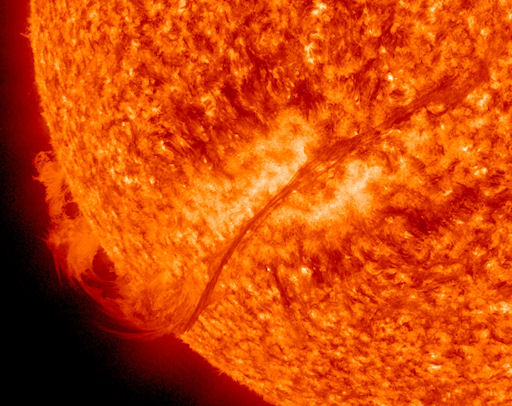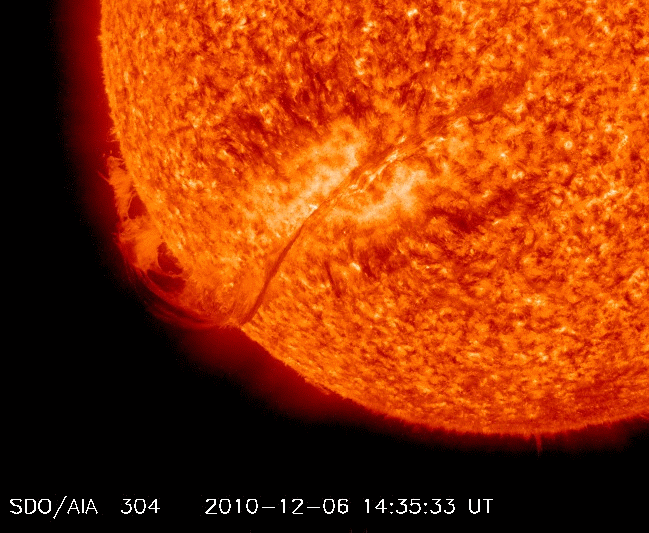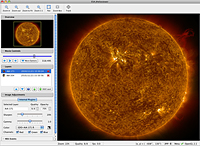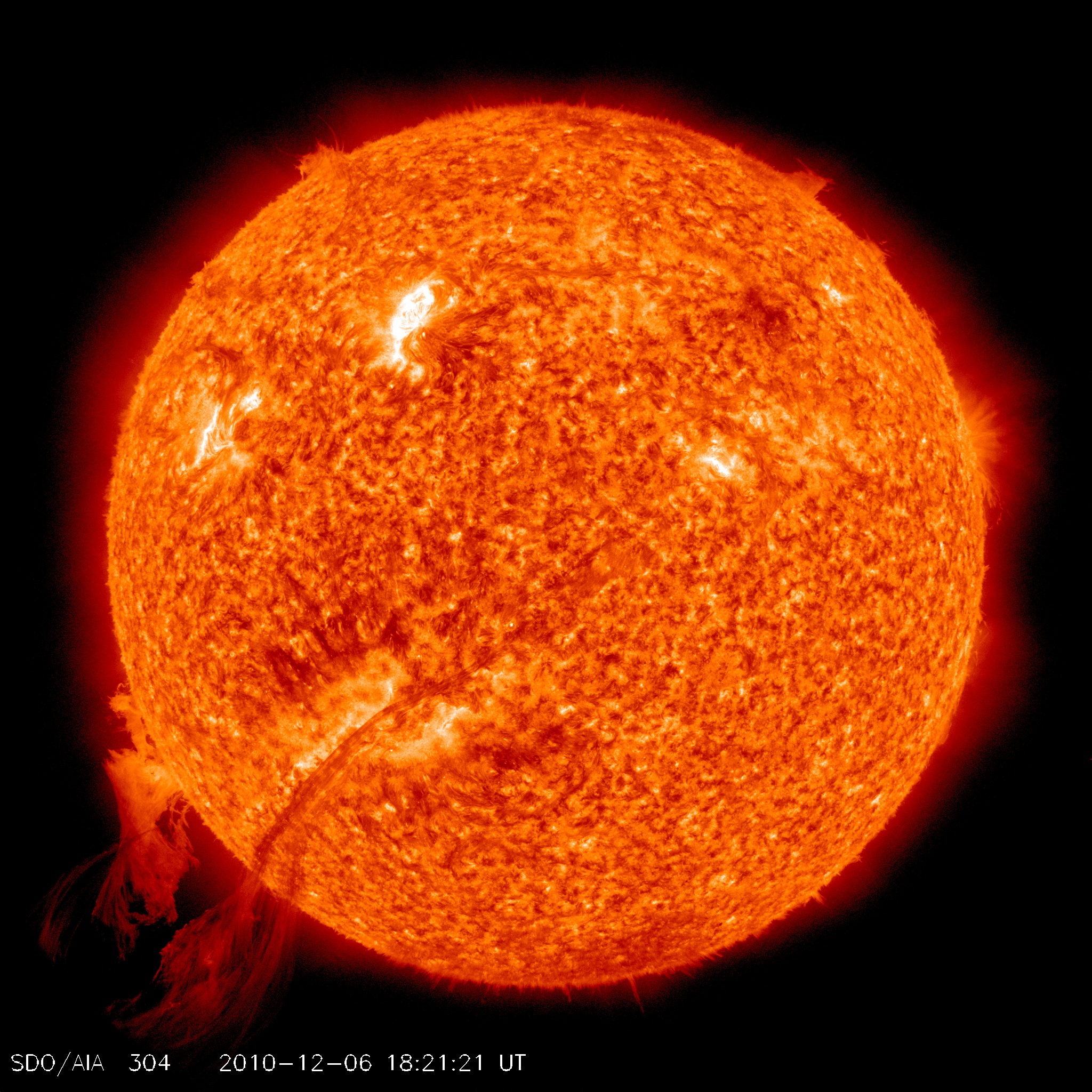Photographic documentation of a Space Shuttle launch plays a critical role in the engineering analysis and evaluation process that takes place during each and every mission. Motion and Still images enable Shuttle engineers to visually identify off-nominal events and conditions requiring corrective action to ensure mission safety and success. This imagery also provides highly inspirational and educational insight to those outside the NASA family.

dinsdag 21 december 2010
Tour of the ISS
Nu heb je de gelegenheid om in het ISS ruimtevaartcomplex
eens rond te zweven. Frank de Winne is ook even te zien
in deze enorm grote behuizing.... toch speciaal
International Space Station Tour
donderdag 16 december 2010
Butterfly emerges from stellar demise in planetary nebula NGC 6302.
This celestial object looks like a delicate butterfly. But it is far from serene.
What resemble dainty butterfly wings are actually roiling cauldrons of gas heated to nearly 20 000 degrees Celsius. The gas is tearing across space at more than 950 000 kilometres per hour — fast enough to travel from Earth to the Moon in 24 minutes!
A dying star that was once about five times the mass of the Sun is at the centre of this fury. It has ejected its envelope of gases and is now unleashing a stream of ultraviolet radiation that is making the cast-off material glow. This object is an example of a planetary nebula, so-named because many of them have a round appearance resembling that of a planet when viewed through a small telescope.
The Wide Field Camera 3 (WFC3), a new camera aboard the NASA/ESA Hubble Space Telescope, snapped this image of the planetary nebula, catalogued as NGC 6302, but more popularly called the Bug Nebula or the Butterfly Nebula. WFC3 was installed by NASA astronauts in May 2009, during the Servicing Mission to upgrade and repair the 19-year-old Hubble.
NGC 6302 lies within our Milky Way galaxy, roughly 3800 light-years away in the constellation of Scorpius. The glowing gas is the star's outer layers, expelled over about 2200 years. The "butterfly" stretches for more than two light-years, which is about half the distance from the Sun to the nearest star, Proxima Centauri.
The central star itself cannot be seen, because it is hidden within a doughnut-shaped ring of dust, which appears as a dark band pinching the nebula in the centre. The thick dust belt constricts the star's outflow, creating the classic "bipolar" or hourglass shape displayed by some planetary nebulae.
The star's surface temperature is estimated to be over 220 000 degrees Celsius, making it one of the hottest known stars in our galaxy. Spectroscopic observations made with ground-based telescopes show that the gas is roughly 20 000 degrees Celsius, which is unusually hot compared to a typical planetary nebula.
The WFC3 image reveals a complex history of ejections from the star. The star first evolved into a huge red giant, with a diameter of about 1000 times that of our Sun. It then lost its extended outer layers. Some of this gas was cast off from its equator at a relatively slow speed, perhaps as low as 32 000 kilometres per hour, creating the doughnut-shaped ring. Other gas was ejected perpendicular to the ring at higher speeds, producing the elongated "wings" of the butterfly-shaped structure. Later, as the central star heated up, a much faster stellar wind, a stream of charged particles travelling at more than 3.2 million kilometres per hour, ploughed through the existing wing-shaped structure, further modifying its shape.
The image also shows numerous finger-like projections pointing back to the star, which may mark denser blobs in the outflow that have resisted the pressure from the stellar wind.
The nebula's reddish outer edges are largely due to light emitted by nitrogen, which marks the coolest gas visible in the picture. WFC3 is equipped with a wide variety of filters that isolate light emitted by various chemical elements, allowing astronomers to infer properties of the nebular gas, such as its temperature, density and composition.
The white-coloured regions are areas where light is emitted by sulphur. These are regions where fast-moving gas overtakes and collides with slow-moving gas that left the star at an earlier time, producing shock waves in the gas (the bright white edges on the sides facing the central star). The white blob with the crisp edge at upper right is an example of one of those shock waves.
NGC 6302 was imaged on 27 July 2009 with Hubble's Wide Field Camera 3 in ultraviolet and visible light. Filters that isolate emissions from oxygen, helium, hydrogen, nitrogen and sulphur from the planetary nebula were used to create this composite image.
These Hubble observations of the planetary nebula NGC 6302 are part of the Hubble Servicing Mission 4 Early Release Observations.
Credit:
NASA, ESA and the Hubble SM4 ERO Team
ESA maakt de zon voor iedereen beschikbaar
A mega-filament erupts on the Sun as seen on JHelioviwer
14 December 2010
New software developed by ESA makes available online to everyone, everywhere at anytime, the entire library of images from the SOHO solar and heliospheric observatory. Just download the viewer and begin exploring the Sun.
| A solar prominence in JHelioviewer |
| A prominence arcs up from the solar surface. |
“We wanted to make it easy to view solar images from different observatories and instruments, and to make it easy to make movies,” says Daniel Müller, ESA SOHO Deputy Project Scientist. “Before, it took hours to combine images from different telescopes to make a movie of the Sun for a given period. With JHelioviewer, everyone can do this in minutes. This is an interactive visual archive of the entire SOHO mission.”
| A prominence twists above the solar surface. |
The code can even be reused for other purposes; it is already being used for Mars data and in medical research. This is because JHelioviewer does not need to download entire datasets, which can often be huge – it can just choose enough data to stream smoothly over the Internet.
| An eruption blasts from the Sun on JHelioviewer |
“The goal of JHelioviewer, and the Helioviewer Project as a whole, is to offer intuitive interfaces to large datasets from many different sources. In effect, it is a virtual observatory,” says Müller.
For more information, click here
Solar storms erupt from the Sun in JHelioviewer
Bron: http://www.esa.int/esaCP/SEMYTMRRJHG_index_0.html
Jingle Bells was the first song played in space
This harmonica, and these bells, are sitting in the Smithsonian Museum today. In 1965, however, they were in space, with astronauts Walter M. "Wally" Schirra Jr. and Thomas P. Stafford, who were doing a pre-Christmas mission aboard Gemini 6.
Just before Stafford and Schirra were scheduled to reenter Earth's atmosphere December 16, the pair reported they had sighted some sort of UFO. Schirra recounted the moment when Stafford contacted Mission Control in Schirra's Space, a memoir he wrote with Richard Billings:Thanks to leharrist for Submitterating!
"We have an object, looks like a satellite going from north to south, probably in polar orbit.... Looks like he might be going to re-enter soon.... You just might let me pick up that thing.... I see a command module and eight smaller modules in front. The pilot of the command module is wearing a red suit."
Then ground controllers heard the strains, both familiar and otherworldly, of "Jingle Bells." The Santa Claus plot had been hatched weeks before the Gemini 6 mission. "Wally came up with the idea," recalls Stafford, now a retired Air Force general, who chairs an International Space Station advisory group. "He could play the harmonica, and we practiced two or three times before we took off, but of course we didn't tell the guys on the ground."
"I could hear the voices at Mission Control getting tense," Stafford adds, "when I talked about sighting something else up there with us. Then, after we finished the song, [Mission Control's] Elliot See relaxed and just said, 'You're too much.'"
dinsdag 14 december 2010
Tapes van Apollo 13 vrijgegeven
10, 9, 8, 7, 6, — Tapes van Apollo 13 vrijgegeven
Wat vertellen ruimtevaarders tegen elkaar tijdens een vlucht? NASA geeft de gesprekken aan boord van haar maanmissies vrij.
De Amerikaanse ruimtevaartorganisatie NASA heeft de gesprekken aan boord van de mislukte maanmissie Apollo 13 openbaar gemaakt. Ook van de eerste succesvolle maanmissie Apollo 11 uit 1969 worden binnenkort uitgeschreven tapes vrijgegeven op de website spacelog.org.
Op dit moment zijn daar al de transcripties te vinden van gesprekken die werden opgenomen aan boord van twee ruimtemissies: Apollo 13 (1970) en Mercury 3 (1962).
Vooral Apollo 13 is interessant, omdat het om een van de eerste en meest befaamde missies naar de maan gaat. De missie werd voortijdig afgebroken nadat er een zuurstoftank scheurde en de elektrische systemen beschadigd raakten.
In de transcripties staat onder meer te lezen hoe astronaut Jack Swigert het begin van het onheil aan vluchtbegeleider Joseph P. Kerwin meedeelt (“Hey Joe. Jim vertelt dat er een walm van, je weet wel, een brandgeur hangt in het tunnelgedeelte.”).
Succesvolle mislukking
In de uitgeschreven tapes staan ook meer triviale conversaties. Zo blijkt dat Swiger vlak na de lancering aan het raden was boven welk land ze zich bevonden. Waarbij leidinggevende Jim Lovell hem er blijkbaar op attent moest maken dat het blauw onder hen wel degelijk water was. Met de hint dat ze zich in de westelijke hemisfeer bevonden, besloot Swigert dat de Apollo 13 hen op dat ogenblik over de Golf van Mexico voerde.
Ondanks de technische problemen slaagden de ruimtevaarders er uiteindelijk in om veilig naar de Aarde terug te keren. ‘Een succesvolle mislukking’ werd de missie daarom achteraf genoemd.
De NASA heeft aangekondigd dat ze nog meer transcripties van ruimtemissies publiek zal maken. Daarbij onder meer de gesprekken tijdens de Apollo 11-missie uit 1969, die in de eerste succesvolle landing op de maan resulteerde.
Bron: http://knack.rnews.be/nl/actualiteit/nieuws/wetenschap/
maandag 13 december 2010
Mooie foto's.
The Soyuz TMA-20 spacecraft is seen as it arrives at the launch pad Monday, Dec. 13, 2010 at the Baikonur Cosmodrome in Kazakhstan. The Soyuz is scheduled to launch the crew of Expedition 26 Wednesday at 2:09 p.m. EST.
Less than a year after its birth, the National Aeronautics and Space Agency announced its first astronaut class, the Mercury Seven, on April 9, 1959. Project Mercury proved that humans could live and work in space, paving the way for all future human exploration.
This cutaway drawing of the Mercury capsule was used by the Space Task Group at the first NASA inspection, on Oct. 24, 1959.
Answer to Cities from Space Challenge #2: Hahah Scott Poovey is right! It is London!
NASA Image of the Day: Galaxy Triplet ARP 274
On April 1-2, the Hubble Space Telescope photographed the winning target in the Space Telescope Science Institute’s 'You Decide' competition in celebration...http://www.nasa.gov/multimedia/imagegall
On April 1-2, the Hubble Space Telescope photographed the winning target in the Space Telescope Science Institute’s 'You Decide' competition in celebration...http://www.nasa.gov/multimedia/imagegall
Projecy Mercury Explained
Less than a year after its birth, the National Aeronautics and Space Agency announced its first astronaut class, the Mercury Seven, on April 9, 1959. Project Mercury proved that humans could live and work in space, paving the way for all future human exploration.
This cutaway drawing of the Mercury capsule was used by the Space Task Group at the first NASA inspection, on Oct. 24, 1959.
Love this Cassini pic of Saturn! How cool is that? It's from Astronomy Pic of the Day.
Love this pic of the Space Station taken by the departing STS-119 crew. Had to share!
dinsdag 7 december 2010
Mega-filament op de Zon komt tot uitbarsting
 Een gigantisch magnetisch filament op het zuidelijk halfrond van de Zon is vandaag uitgebarsten.
Een gigantisch magnetisch filament op het zuidelijk halfrond van de Zon is vandaag uitgebarsten.Het gedeelte van het filament wat zichtbaar is strekt zich uit over een afstand van maar liefst 700.000 kilometer. Eerder op de dag nam het Solar Dynamics Observatory een foto van het fenomeen.
Ruimtesonde STEREO-B, gestationeerd nabij de oostelijke horizon van de Zon, zag het filament vorige week ontstaan.
Het object bleef tot voor kort rustig boven het oppervlak van de ster hangen, maar begon tekenen van instabiliteit te vertonen.
De eruptie lijkt in eerste instantie niet geoeffectief te zijn.

maandag 6 december 2010
donderdag 2 december 2010
Object ter grootte van Jupiter nabij rand zonnestelsel?
 Wetenschappers denken dat een object ter grootte van de planeet Jupiter zich nabij de rand van ons zonnestelsel bevindt. Zou het hier misschien kunnen gaan om de planeet Niburu? Wetenschappers denken dat een object ter grootte van de planeet Jupiter zich nabij de rand van ons zonnestelsel bevindt. Zou het hier misschien kunnen gaan om de planeet Niburu?“We hebben nu genoeg data en kometen onderzocht om deze hypothesis te testen”, zei planetair wetenschapper John Matese van de Universiteit van Louisiana. “Enkel nu kunnen we vaststellen of zich daar een dergelijk object bevindt.” Dwergster In een nieuwe analyse van observaties, die teruggaan tot 1898, stellen Matese en zijn collega Whitmire vast dat ongeveer 20% van de zichtbare kometen ons zonnestelsel hebben bereikt door de invloed van een ver object. Het idee was een reactie op de eerdere suggestie van doemdenkers dat op de plaats aan de rand van het zonnestelsel een zwakke bruine of rode dwergster kon staan die elke 30 miljoen jaar een regen aan kometen op ons afstuurt en beter bekend staat als 'Nemesis'. Later onderzoek wees echter uit dat deze hypothese erg onwaarschijnlijk is. “Maar we begonnen ons af te vragen wat voor object we dan konden afleiden uit de huidige data die we zien”, zei Matese. “Welke kracht kan ervoor zorgen dat kometen zo dicht bij de Zon komen dat we ze kunnen zien?” Oortwolk De kosmische sneeuwballen bevinden zich meestal in de Oortwolk tot hun baan door een kracht van buitenaf verandert. Dit kan drie redenen hebben, zo stelt Matese. De constante aantrekking van de Melkweg kan kometen in de richting van ons zonnestelsel duwen. Daarnaast kan een passerende ster kometen uit de Oortwolk schudden. Tot slot kan een groot object in de vorm van een planeet of dwergster de kometen in de richting van onze Zon duwen. In elk van de scenario’s wordt een bepaald patroon zichtbaar aan de nachtelijke hemel. Nadat het team de baan van meer dan 100 kometen uit de Minor Planet Center database had onderzocht, kwamen ze tot de conclusie dat 80% van de kometen uit de Oortwolk in de richting van ons zonnestelsel werd geduwd door de zwaartekracht van de Melkweg. De overige 20% had echter een duw nodig van een object met ongeveer 1,4 keer de massa van planeet Jupiter. WISE Het patroon wordt alleen zichtbaar voor kometen die uit het buitenste bolvormige gedeelte van de Oortwolk komen, wat zich tussen 0,3 en 0,8 lichtjaar afstand van de Zon bevindt. Kometen uit het plattere, donutvormige, binnenste gedeelte van de Oortwolk creëren niet hetzelfde karakteristieke patroon. Waarschijnlijk krijgen we binnen nu en tien jaar meer duidelijkheid omdat meerdere onderzoeken online gaan verschijnen, waarbij de data over kometen die nu bekend zijn in het niet zullen vallen. Wellicht kan dan een verklaring worden gevonden voor de asymmetrische baan van de kometen. Matese merkt op dat WISE, NASA’s infraroodtelescoop, tot die tijd uitkomst kan bieden, omdat hiermee het object zichtbaar zou kunnen worden gemaakt.  Bron: |
Abonneren op:
Posts (Atom)
















